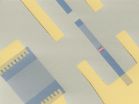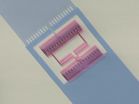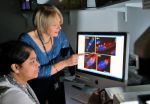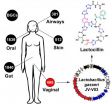(Press-News.org) Researchers at Chalmers University of Technology are first to show the use of sound to communicate with an artificial atom. They can thereby demonstrate phenomena from quantum physics with sound taking on the role of light. The results will be published in the journal Science.
The interaction between atoms and light is well known and has been studied extensively in the field of quantum optics. However, to achieve the same kind of interaction with sound waves has been a more challenging undertaking. The Chalmers researchers have now succeeded in making acoustic waves couple to an artificial atom. The study was done in collaboration between experimental and theoretical physicists.
"We have opened a new door into the quantum world by talking and listening to atoms", says Per Delsing, head of the experimental research group. "Our long term goal is to harness quantum physics so that we can benefit from its laws, for example in extremely fast computers. We do this by making electrical circuits which obey quantum laws, that we can control and study."
An artificial atom is an example of such a quantum electrical circuit. Just like a regular atom, it can be charged up with energy which it subsequently emits in the form of a particle. This is usually a particle of light, but the atom in the Chalmers experiment is instead designed to both emit and absorb energy in the form of sound.
"According to the theory, the sound from the atom is divided into quantum particles", says Martin Gustafsson, the article's first author. "Such a particle is the weakest sound that can be detected."
Since sound moves much slower than light, the acoustic atom opens entire new possibilities for taking control over quantum phenomena.
"Due to the slow speed of sound, we will have time to control the quantum particles while they travel" says Martin Gustafsson. "This is difficult to achieve with light, which moves 100,000 times more quickly."
The low speed of sound also implies that it has a short wavelength compared to light. An atom that interacts with light waves is always much smaller than the wavelength. However, compared to the wavelength of sound, the atom can be much larger, which means that its properties can be better controlled. For example, one can design the atom to couple only to certain acoustic frequencies or make the interaction with the sound extremely strong.
The frequency used in the experiment is 4.8 gigahertz, close to the microwave frequencies common in modern wireless networks. In musical terms, this corresponds approximately to a D28, about 20 octaves above the highest note on a grand piano.
At such high frequencies, the wavelength of the sound becomes short enough that it can be guided along the surface of a microchip. On the same chip, the researchers have placed an artificial atom, which is 0.01 millimeters long and made of a superconducting material.
INFORMATION:
Additional details about the research:
The sample that the researchers use is made on a substrate of gallium arsenide (GaAs) and contains two important parts. The first one is the superconducting circuit that constitutes the artificial atom. Circuits of this kind can also be used as qubits, the building blocks of a quantum computer. The other essential component is known as an interdigital transducer (IDT). The IDT converts electrical microwaves to sound and vice versa. The sound used in the experiment has the form of surface acoustic waves (SAWs) which appear as ripples on the surface of a solid. The experiments are performed at very low temperatures, near absolute zero (20 millikelvin), so that energy in the form of heat does not disturb the atom.
The theoretical research group, led by Göran Johansson, recently published a paper on how the acoustic atom functions:
http://link.aps.org/doi/10.1103/PhysRevA.90.013837
The research was funded by the Swedish Research Council, the Knut and Alice Wallenberg Foundation, the European Research Council and the Wenner-Gren Foundations.
The sound of an atom has been captured
2014-09-11
ELSE PRESS RELEASES FROM THIS DATE:
New genetic targets discovered in fight against muscle-wasting disease
2014-09-11
Scientists have pinpointed for the first time the genetic cause in some people of an incurable muscle-wasting disease, Emery-Dreifuss muscular dystrophy (EDMD).
The international research team led by the University of Leicester say the finding of two target genes opens the possibility of developing drugs to tackle the disease in these patients. Their work has been published today in the journal PLOS Genetics.
The research was funded by The Wellcome Trust and was only possible by the University of Leicester team collaborating with groups in Germany (University of Greifswald), ...
New species of electrons can lead to better computing
2014-09-11
In a research paper published this week in Science, the collaboration led by MIT's theory professor Leonid Levitov and Manchester's Nobel laureate Sir Andre Geim report a material in which electrons move at a controllable angle to applied fields, similar to sailboats driven diagonally to the wind.
The material is graphene – one atom-thick chicken wire made from carbon – but with a difference. It is transformed to a new so-called superlattice state by placing it on top of boron nitride, also known as `white graphite', and then aligning the crystal lattices of the two materials. ...
'Hot Jupiters' provoke their own host suns to wobble
2014-09-11
Blame the "hot Jupiters."
These large, gaseous exoplanets (planets outside our solar system) can make their suns wobble when they wend their way through their own solar systems to snuggle up against their suns, according to new Cornell University research to be published in Science, Sept. 11.
Images: https://cornell.box.com/lai
"Although the planet's mass is only one-thousandth of the mass of the sun, the stars in these other solar systems are being affected by these planets and making the stars themselves act in a crazy way," said Dong Lai, Cornell professor of ...
Diversified farming practices might preserve evolutionary diversity of wildlife
2014-09-11
As humans transform the planet to meet our needs, all sorts of wildlife continue to be pushed aside, including many species that play key roles in Earth's life-support systems. In particular, the transformation of forests into agricultural lands has dramatically reduced biodiversity around the world.
A new study by scientists at Stanford and the University of California, Berkeley, in this week's issue of Science shows that evolutionarily distinct species suffer most heavily in intensively farmed areas. They also found, however, that an extraordinary amount of evolutionary ...
You can classify words in your sleep
2014-09-11
When people practice simple word classification tasks before nodding off—knowing that a "cat" is an animal or that "flipu" isn't found in the dictionary, for example—their brains will unconsciously continue to make those classifications even in sleep. The findings, reported in the Cell Press journal Current Biology on September 11, show that some parts of the brain behave similarly whether we are asleep or awake and pave the way for further studies on the processing capacity of our sleeping brains, the researchers say.
"We show that the sleeping brain can be far more ...
Gut microbes determine how well the flu vaccine works
2014-09-11
Annual flu epidemics cause millions of cases of severe illness and up to half a million deaths every year around the world, despite widespread vaccination programs. A study published by Cell Press on September 11th in Immunity reveals that gut microbes play an important role in stimulating protective immune responses to the seasonal flu vaccine in mice, suggesting that differences in the composition of gut microbes in different populations may impact vaccine immunity. The study paves the way for global public health strategies to improve the effectiveness of the flu vaccine. ...
Stem cells help researchers understand how schizophrenic brains function
2014-09-11
Using human induced pluripotent stem cells (hiPSCs), researchers have gained new insight into what may cause schizophrenia by revealing the altered patterns of neuronal signaling associated with this disease. They did so by exposing neurons derived from the hiPSCs of healthy individuals and of patients with schizophrenia to potassium chloride, which triggered these stem cells to release neurotransmitters, such as dopamine, that are crucial for brain function and are linked to various disorders. By discovering a simple method for stimulating hiPSCs to release neurotransmitters, ...
Intestinal bacteria needed for strong flu vaccine responses in mice
2014-09-11
Mice treated with antibiotics to remove most of their intestinal bacteria or raised under sterile conditions have impaired antibody responses to seasonal influenza vaccination, researchers have found.
The findings suggest that antibiotic treatment before or during vaccination may impair responses to certain vaccines in humans. The results may also help to explain why immunity induced by some vaccines varies in different parts of the world.
In a study to be published in Immunity, Bali Pulendran, PhD, and colleagues at Emory University demonstrate a dependency on gut ...
Our microbes are a rich source of drugs, UCSF researchers discover
2014-09-11
Bacteria that normally live in and upon us have genetic blueprints that enable them to make thousands of molecules that act like drugs, and some of these molecules might serve as the basis for new human therapeutics, according to UC San Francisco researchers who report their new discoveries in the September 11, 2014 issue of Cell.
The scientists purified and solved the structure of one of the molecules they identified, an antibiotic they named lactocillin, which is made by a common bacterial species, Lactobacillus gasseri, found in the microbial community within the vagina. ...
Cells put off protein production during times of stress
2014-09-11
DURHAM, N.C. -- Living cells are like miniature factories, responsible for the production of more than 25,000 different proteins with very specific 3-D shapes. And just as an overwhelmed assembly line can begin making mistakes, a stressed cell can end up producing misshapen proteins that are unfolded or misfolded.
Now Duke University researchers in North Carolina and Singapore have shown that the cell recognizes the buildup of these misfolded proteins and responds by reshuffling its workload, much like a stressed out employee might temporarily move papers from an overflowing ...





